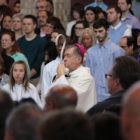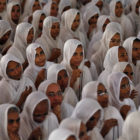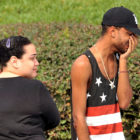[slingshot_ad name=”Slingshot Banner Ad”]
Need to know: Tuesday, June 14, 2016
Trump pushes expanded ban on Muslims entering the U.S.
He accuses American Muslims of harboring terrorists in a speech “laden with falsehoods and exaggeration.”
What queer Muslims are saying about the Orlando shooting
They mourn the tragedy as they fear an anti-Muslim backlash.
Fundamentalist pastor praises the Orlando attacks
"Are you sad that 50 pedophiles were killed today?" he said in his Sunday sermon. “I think that’s great.”
Evangelist’s child
A nephew says his uncle, Oral Roberts’ son, was gay and his truth must be known.

Christians respond to Orlando massacre
Not all LGBT Christians heard good news in the well-meaning statements made by some prominent Christians.
[slingshot_ad name=”Slingshot Middle Cube Ad”]
Latest news from RNS

Pakistani clerics declare ‘honor killing’ against Islam
LAHORE, Pakistan - Hundreds of Pakistanis, the vast majority women and girls, are murdered every year by relatives after being accused of damaging a family's honor.

Chicago archbishop decries targeting of gays in Orlando attack
Archbishop Blase Cupich was one of the few Catholic churchmen to specifically cite a reason the victims were massacred.

Aid to dying: What Jainism – one of India’s oldest religions – teaches us
On June 9, a law allowing patients with terminal illnesses to end their lives with help from a physician came into effect in California, opening conversations about whether human life should be prolonged against the desire to die peacefully and with dignity.
RELATED STORY: California’s End of Life Option law: More peaceful deaths or moral quicksand?
A similar yet different conversation has been taking place in India for the past several years, but in reverse. In one of India’s religious traditions, Jainism, those at the end of life can choose to embrace a final fast transition from one body to another. However, a recent court case has challenged the constitutionality of this practice. As an expert in the religions of India and a frequent visitor, I have been following this issue with keen interest.
RELATED STORY: California’s End of Life Option law: More peaceful deaths or moral quicksand?
A similar yet different conversation has been taking place in India for the past several years, but in reverse. In one of India’s religious traditions, Jainism, those at the end of life can choose to embrace a final fast transition from one body to another. However, a recent court case has challenged the constitutionality of this practice. As an expert in the religions of India and a frequent visitor, I have been following this issue with keen interest.
A rite to final passage
While on a visit to a Jain university in Ladnun, Rajasthan in western India in 1989, I had an opportunity to observe the practice of “Sallekhana” or “Santhara,” a somber rite through which one fasts to death. A group of enthusiastic nuns rushed me in for a blessing being imparted to an octogenarian nun, Sadhvi Kesharji, who had taken this vow 28 days earlier. The nun had been diagnosed with a fatal kidney disease and been treated, but to no avail. It was an auspicious moment. Her spiritual preceptor, Acharya Tulsi, praised her six decades as a nun and noted the lightness of her spirit and the strength of her resolve which guaranteed safe passage into her next incarnation. She passed away 12 days later, in a prayerful state. This is not the only such case. It is estimated that some 200 Jains, both lay and monastic, complete the final fast each year. Jains living elsewhere in the world observe the practice as well. For example, two Jain women who were born in India but spent most of their adult lives in the United States chose to fast in the last days prior to death. Vijay Bhade, a Jain woman from West Virginia, entered a fast unto death in 1997. A more recent case was Bhagwati Gada, from Texas, who suffered from advanced stage cancer and decided to fast unto death in 2013, after going through multiple rounds of chemotherapy.Who are the Jains?
Jainism arose more than 2,800 years ago in northeast India. It teaches a doctrine proclaiming the existence of countless eternal souls who, due to their actions or karma, bind themselves to repeated lifetimes. These souls could manifest as elemental beings in the earth or water or fire or air. They could evolve to become micro-organisms and plants or eventually take forms as worms, insects, birds, reptiles or mammals. By committing acts of goodness, they might take human form and ascend to a place of everlasting freedom at the highest limits of the universe, from which they continue to observe forever the repeated rounds of existence experienced by the many souls below. Jains do not believe in a creator God or an external controller. All experiences, good and bad, are due to one’s own exertions. The key to spiritual ascent resides in the performance of five vows also shared by Yogis and Buddhists in India: nonviolence, truthfulness, not stealing, celibacy and nonpossession. Jains believe the practice of these vows helps release fettering karmas that impede the energy, consciousness and bliss of the soul. Every ethical success lightens the soul of its karmic burden. Mohandas Gandhi, the well-known leader of India’s independence, who grew up in the company of Jains, employed these vows personally and as a collective strategy of nonviolence to help India overcome the shackles of British colonization.Freedom yes, but can there be coercion?
Up until recent years, the fast unto death process has been celebrated with newspaper announcements that laud the monks, nuns, laymen and laywomen who undergo this vow. But of late, questions are being raised whether it can result in coercion and cruelty. In 2006, a young lawyer in Rajasthan, Nikhil Soni, challenged the constitutionality of this act, stating that it violates the anti-suicide laws that had been in put place by the British to stop the immolation of widows on their husband’s funeral pyre. The practice of widow burning has endured, despite many efforts to abolish the practice. The high court of Rajasthan ruled in favor of Soni in 2015, effectively making the practice of fasting to death punishable by law. However, some weeks later, the Supreme Court of India placed a stay on this ruling. The case is still awaiting its final verdict. Observant Jains claim this is an important part of their faith. Entering the fast requires counsel and permission from one’s spiritual advisor. And the process of rejection of food is gradual. First, one takes some yogurt, then only milk, then only juice, eventually moving from water to total rejection of any nutrition or hydration. Physicians state that this is not death by starvation but by dehydration. The body automatically goes into a state of ketosis (when the body starts to break down stored fat for energy), often accompanied by a peaceful state.Rights versus rites approach
What can we learn from such spiritual practices? Debates on end of life focus on the “rights” approach, thus appealing to the rational mind. Spiritual traditions on the other hand assert that it makes no sense to prolong suffering. They use a “rites” approach to the inevitable passing of the human body. Jains believe that the soul has always been here, that the soul cannot be destroyed and that through the process of death, one transitions to a new body. The Jain tradition shows how we can move without attachment into death rather than clinging to life. In their acceptance of the inevitable, they set an example that death is not an evil but an opportunity to reflect on a life well-lived and look forward to what lies ahead. (Christopher Key Chapple, a professor of Indic and Comparative Theology at Loyola Marymount University wrote this article for The Conversation, where it was first published)More views from RNS

God weeps over Orlando
God weeps over what happened in Orlando. Now, what are we going to do?

Caught between two cultures
(RNS) What leads the son of immigrants from a far-flung conservative nation to reportedly abuse his ex-wife and be repulsed by homosexuality?

Who’s a heretic? Martin Luther, Pope Saint John Paul, Pope Benedict and Pope Francis
Popes have been interested in heresy and heretics for centuries, and language linking “papacy” and “heresy” continues to prosper down to our own day. The language root of “heresy” connects with “to choose,” and the heretic is someone who, in the eyes of someone else, makes bad choices.
Those of us who are not of the papal obedience, particularly of the Lutheran tribe, will commemorate, this very Wednesday, the condemnation of Martin Luther, called a “heretic” on June 15, 1520. According to best estimates, .0001520% of the world’s Lutherans and even fewer Protestants and other heirs of the Reformation will be aware of this, or will observe the day. Never mind: the date provides us with an excuse to update dealings with the papacy and heretics.
Pope Francis’ sermon at morning mass last Thursday, June 9, departed from tradition. He counseled congregants to seek reconciliation with others instead of confronting them with “take it or leave it” evangelistic styles. Francis invoked authority, as popes tend to do, in this case citing one Jesus, who adopted and exemplified “healthy realism.”
Quote Francis: “It’s not Catholic (to say) “this or nothing.” His judgment: “This is not Catholic, this is heretical.” He counseled instead the “sanctity of negotiations.” More: “Jesus is a great person! He frees us from all our miseries, and also from that idealism which is not Catholic.”
That is not the last word or the only approach to this subject from Pope Francis and, needless to say, Jesus. But it is the overlooked theme in a world of believers who are sure that they are always right and “the other” is always wrong, beyond negotiation, heretical, and worthy of equivalents of excommunication.
Pope Leo X was sure he was right and Luther & Co. were wrong, and the pontiff’s language was not gentle. That pope’s “bull”—which we remind all, is a technical ecclesiastical term, spoke of the young and brassy monk Luther not as a raging bull, but a wild boar who had invaded God’s vineyard, the church.
In case readers have been lulled by the pacific negotiator Francis, it is important to note that, surprise!, the pope is being declared heretical by people whose authority is invested in the internet. Sightings is embedding numbers of links which will give readers a sense of what is being directed against this pope and two of his predecessors.
We have not thought of Pope Benedict XVI or Pope Saint John Paul as heretics, but who are we to judge? We have thought of them as unassailably orthodox, but the quotable words from Catholics on the right, or the far right, or the far far right, do judge.
Leo X found only 41 heresies in the excommunicable Luther, but some Catholic writers and leaders of the far far far right find 101 or more heresies issued from the Throne of Peter during the last three papacies. We could publish some of their language here, but a) we are tender souls, easily offended by such language; b) not Catholic who should keep silence; or c) do not want to deprive readers of an opportunity to enrich their language of vituperation during the war against empathy and negotiation.
Non-Catholics don’t have to worry about suffering excommunication, but they may learn from the positive language and efforts of the Catholics who would plead, as Pope Francis has just done, to resist what the headline calls a “my-way-or-the-highway faith,” here called “heretical.” Many of the heirs of the “wild boars” in the vineyard are enjoying the spirit of Pope Francis, and will cite him in our celebrations on Wednesday, June 15.
 Author, Martin E. Marty, is the Fairfax M. Cone Distinguished Service Professor Emeritus of the History of Modern Christianity at the University of Chicago Divinity School. His biography, publications, and contact information can be found at www.memarty.com.
Author, Martin E. Marty, is the Fairfax M. Cone Distinguished Service Professor Emeritus of the History of Modern Christianity at the University of Chicago Divinity School. His biography, publications, and contact information can be found at www.memarty.com.
This post appears courtesy of Sightings, a publication of the University of Chicago Divinity School’s Martin Marty Center. To read previous issues of Sightings, click here.
 Author, Martin E. Marty, is the Fairfax M. Cone Distinguished Service Professor Emeritus of the History of Modern Christianity at the University of Chicago Divinity School. His biography, publications, and contact information can be found at www.memarty.com.
Author, Martin E. Marty, is the Fairfax M. Cone Distinguished Service Professor Emeritus of the History of Modern Christianity at the University of Chicago Divinity School. His biography, publications, and contact information can be found at www.memarty.com.
This post appears courtesy of Sightings, a publication of the University of Chicago Divinity School’s Martin Marty Center. To read previous issues of Sightings, click here.
[slingshot_ad name=”Slingshot Bottom Cube Ad”]




